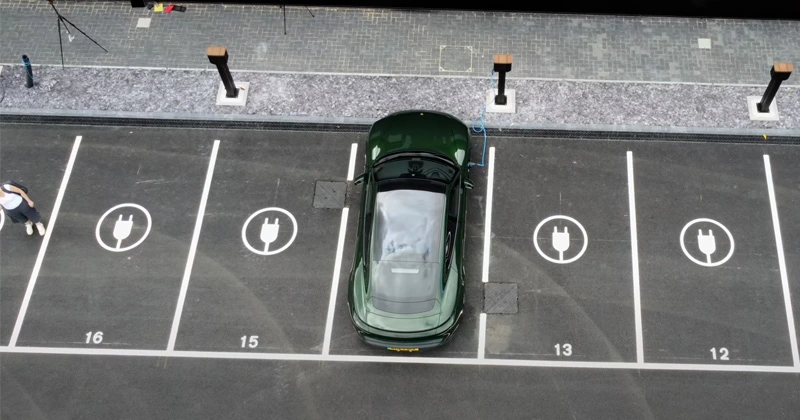As the world transitions to renewable energy and electric vehicles (EVs), combining solar power with EV charging presents an exciting opportunity for businesses, apartment dwellers, solar installers, and Charge Point Operators (CPOs). In this article, we’ll explore the transformative potential of integrating EV charging with solar energy to drive sustainability and unlock significant economic benefits.
The Rise of Solar Power and EVs
Solar power has become a dominant force in renewable energy, responsible for 55% of all new generating capacity added to the U.S. grid in 2023. This growth has continued into 2024, driven by three key factors:
- Federal policies such as the solar Investment Tax Credit (ITC) and the Inflation Reduction Act (IRA).
- Declining costs of solar panels and related equipment.
- Increasing demand for clean energy from industrial and commercial customers.
Corporations have played a key role in this growth, with over half of all solar capacity installed since 2020. In North America alone, almost 19 gigawatts (GW) of solar energy are now installed across 50,000 facilities.
Similarly, federal incentives and regulatory goals are spurring the adoption of EVs. The U.S. has set an ambitious target for 50% of all new vehicle sales to be electric by 2030. A critical aspect of achieving this goal is expanding EV charging infrastructure, particularly at workplaces and multi-dwelling units (MDUs), so commuters and apartment residents can conveniently charge their EVs.
However, despite the shared goals of solar and EV adoption, these technologies are often implemented separately. As a result, many organizations miss out on the potential to maximize energy savings by co-optimizing solar energy and EV charging.
Why Integrating Solar with EV Charging Matters
Solar energy and EV charging are two powerful technologies that, when combined, offer substantial benefits for businesses, apartment complexes, and CPOs. Yet, they are often treated as isolated projects, missing opportunities for greater efficiency and savings. Many organizations simply install EV chargers and solar panels without any coordination between the two systems.
When EV charging is integrated with solar power, intelligent energy management systems can be used to optimize the charging schedule, taking advantage of the times when solar generation is highest. This proactive approach can deliver considerable cost savings and reduce reliance on grid electricity, especially during peak demand hours when electricity costs are highest.
For example, consider a typical workday scenario where employees arrive at the office and plug in their cars at 8:00 a.m. At this time, solar production is low, so without optimization, vehicles are charged using grid power at a higher rate, often around $0.40 per kilowatt-hour (kWh). By 2:00 p.m., when solar production is at its peak, most vehicles have already completed charging, and the excess solar energy is exported to the grid at a much lower rate of $0.10 per kWh.
Now imagine the same scenario with intelligent energy management in place. The system pauses EV charging in the morning when solar generation is low and resumes charging in the afternoon when solar production is at its highest. This simp allows vehicles to charge using solar power, reducing the cost per kWh to around $0.10 and cutting energy costs by as much as 66%.
Charging Scenarios with and Without Solar Optimization
| Time | Event | Charge Cost per kWh without Optimization | Charge Cost per kWh with Optimization |
| 8:00 am | Employees arrive and plug in their vehicles | $0.40 | Charging paused |
| 10:00 am | Solar production begins to ramp up | $0.40 | Charging resumes with solar energy |
| 2:00 pm | Solar production peaks | $0.10 (excess solar exported to the grid) | $0.10 (vehicles charged with solar) |
By integrating EV charging with solar power, organizations can significantly reduce energy costs and maximize the benefits of on-site solar generation. But beyond just economic savings, this co-optimization also contributes to a cleaner, more sustainable energy future.
Beyond Simple Integration: Managing Complex Charging Needs
Co-optimizing solar and EV charging involves more than just timing the charging sessions to coincide with solar production. Commercial buildings, workplaces, and apartment complexes typically have more complex electrical infrastructures and a diverse range of charging requirements.
For instance, while employee vehicles may require slower charging throughout the day, delivery vehicles might need rapid charging to be ready for their next routes. Additionally, different users—such as employees, tenants, and company vehicles—may have different charging priorities. Some may be charged at a discounted rate, while others may receive free charging as part of an employee benefits program.
Managing multiple charge points and vehicle types requires an intelligent energy management platform capable of:
- Prioritizing different vehicles and drivers.
- Optimizing self-consumption of solar power.
- Handling dynamic loads and varying charging requirements.
- Predicting charging patterns and integrating with billing systems.
By using a smart charging management system, businesses can maximize the use of solar energy, reduce costs, and ensure their EV charging infrastructure meets the diverse needs of different users.
Environmental and Social Benefits of Co-Optimization
In addition to economic savings, integrating solar with EV charging supports broader environmental, social, and governance (ESG) goals. By generating and consuming renewable energy on-site, businesses can reduce their carbon footprint and decrease their reliance on grid electricity, which often comes from fossil fuels.
Unlike carbon offsets, which rely on compensating for emissions through third-party projects, on-site solar generation adds physical low-carbon capacity to the grid, directly contributing to a cleaner energy mix. Self-consuming renewable power also helps reduce transmission and distribution losses, easing grid congestion and reducing the need for costly infrastructure upgrades.
From a social perspective, offering workplace or residential EV charging supported by solar energy can help attract and retain talent, especially in industries where sustainability is a core value. According to a survey by Boston Consulting Group, 13% of EV owners charge their vehicles at work due to a lack of charging infrastructure at home. Providing access to solar-powered charging can be a valuable employee benefit and enhance a company’s reputation as a sustainability leader.
The Emerging Market for Solar-Optimized EV Charging in Apartments
With around 44 million Americans living in apartments, the demand for EV charging in multi-dwelling units is rapidly growing. Regulatory initiatives like “right-to-charge” laws are making it easier for apartment residents to access EV charging, creating a significant market opportunity for CPOs and EV charging installers.
Whether a building has on-site solar or not, managing multiple charge points for shared residential use requires sophisticated energy management platforms. These systems can optimize energy consumption for both EV charging and other building loads, ensuring that residents have reliable access to affordable charging while minimizing strain on the grid.
What’s in It for Solar and EV Charging Installers?
For solar installers and CPOs, integrating EV charging with solar represents a lucrative opportunity to offer customers a more comprehensive and sustainable energy solution. However, awareness of the benefits and capabilities of solar-optimized EV charging remains relatively low, making this a prime moment for installers to differentiate themselves by offering advanced energy management solutions.
By providing intelligent energy management platforms alongside traditional hardware installations, installers can demonstrate the economic and environmental advantages of co-optimizing solar and EV charging. This value-added service can help businesses future-proof their energy systems and maximize returns on their renewable energy investments.
Conclusion: A Bright Future for Solar-Optimized EV Charging
As the adoption of solar power and EVs continues to grow, integrating the two technologies is a logical next step for businesses, apartment complexes, and CPOs looking to maximize energy savings and minimize their carbon footprint. Co-optimizing solar energy and EV charging offers a wealth of benefits, from reduced energy costs to enhanced sustainability and improved grid resilience.
By investing in intelligent energy management platforms, organizations can unlock the full potential of solar power and EV charging, ensuring a cleaner, greener, and more cost-effective future for everyone.
At Wevo Energy, we specialize in helping businesses and CPOs integrate solar power with EV charging through our advanced charging management platform. If you’re ready to explore the benefits of solar-optimized EV charging, contact us today to learn more about how we can help you future-proof your energy strategy.


